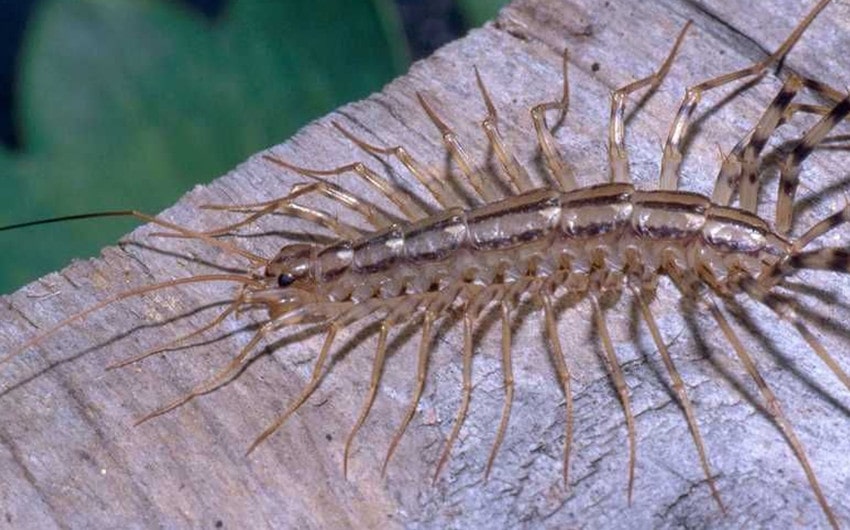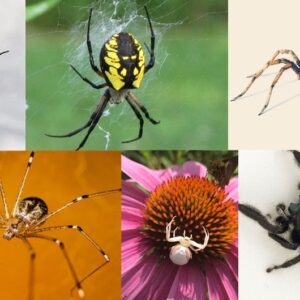
If you’ve spotted a long brown bug with hundreds of thin legs shooting out its body in all directions, you’re most likely looking at a centipede. However, despite their creepy, scary appearance, house centipedes are not always scary and dangerous.
This article will explore all the possible reasons you have centipedes in your house and what you can do to get rid of them. We’ll also explore some of the measures you can take in case of a house centipede bite.
What Are House Centipedes?

Image source: Pinterest
Often called “hundred-leggers,” centipedes are slender insects with hundreds of long and thin legs all over their body. Although their name is not entirely accurate as the number of legs centipedes can have ranges from 15 to 177.
House centipedes are a centipede species inhabiting homes and shelters. You can rarely catch sight of them as they are nocturnal beings with the ability to quickly scurry away when spotted.
Often found in dark, humid, and moist places, centipedes live independently without colonies, nests, or webs. They survive by hunting insects like spiders, ants, cockroaches, wasps, and bedbugs on the move. Capable of holding on to multiple prey, their legs are venomous for small insects.
After stinging their prey, they wait for the venom to take effect before feeding on them. With a relatively longer lifespan than most insects, centipedes can live up to 5–6 years.
Do They Bite?
Though technically centipedes do bite, they generally don’t bite humans and steer clear of them unless provoked or handled roughly. Besides, centipedes pinch or sting rather than bite. Their bites are reserved for their prey.
Moreover, house centipede bites are usually not very painful or strong and rarely cause skin breakage. They are more like a bee sting rather than a full-fledged bite.
Are They Harmful to Humans?

Image source: Pinterest
House centipede bites are mostly venomous for their prey and not very dangerous for humans. Unless you’re allergic to their venom, the most discomfort you’ll experience is mild pain and swelling. The larger the centipede, the more painful the bite. They also rarely cause any serious health issues to dogs or cats.
What Do Centipede Bites Look Like?
When centipedes crawl across the skin, their pincer-like legs can cause blisters and tiny circular wounds on your skin. Centipede bites resemble that of a snake bite with two puncture marks on the bitten area. The bruise can turn red and swollen after a while. The amount of swelling and the depth of the punctures depends on the size of the centipede.
What Are the Symptoms of a Centipede Bite?
Though you are not likely to experience much pain, centipede bites are recognizable from the following common symptoms.
#1. Swelling, blister, mild pain.
#2. Redness around the bitten area.
#3. Headache and anxiety.
#4. Itching and numbness around the bite. In case of severe allergic reactions, you can experience the following symptoms.
#5. Fever, chills, and nausea.
#6. Lymph node swelling.
#7. Bleeding, skin hardening, and throbbing.
#8. Localized infection and tissue death.
#9. Extreme swelling and intense itching around the bitten area. In extremely rare cases, one might experience the following symptoms.
#10. Skin infections.
#11. Blood in the urine.
#11. Heart palpitations.
#12. Excessive bleeding.
#13. Anaphylaxis.
#14. Necrosis.
What Happens After a House Centipede Bites?
After a house centipede bite, you can experience the symptoms mentioned above, though they are often very mild. If you notice any allergic symptoms or infections, immediately consult a doctor.
Are They Venomous?
Yes, centipedes are venomous. They inject venom into their prey through their two front legs. However, this venom is not strong enough to dangerously affect humans. House centipede bites can cause irritations and mild pain, and in most cases, the symptoms and redness disappear within a day or two.
What Should You Do If You Have Been Bitten by a Centipede?
Centipede bites can look like any other insect bites. But if the symptoms are severe, it’s advised to consult a doctor. If you experience no severe complications, use the following first-aid methods to treat the wound.
#1. Thoroughly clean the wound and the surrounding area with soap and water. Since the bite is not a cut, avoid using any alcohol solution.
#2. If you experience no swelling, a hot compress can relieve the pain as it helps dilute the venom.
#3. If there’s swelling, wrap an ice pack in a towel and gently place it on the bite. Make sure to not place unwrapped ice directly on the bite.
#4. In case of severe pain, itching, and allergic reactions, you can use over-the-counter medications like anesthetics, antihistamines, and anti-inflammatory drugs.
Apart from these steps, you can also use a triple antibiotic ointment on the bitten area to ease the pain. Hawaiian rock salt can also be helpful in treating the wound. Papaya pulps are also effective in treating a centipede bite as it contains enzymes that neutralize the centipede’s venom.
What Complications Can Occur from a Centipede Bite?
Complications from house centipede bites can occur due to infections and skin damage around the bitten area. In rare cases when the symptoms aggravate, your doctor may prescribe antibiotics or give you tetanus shots.
If the symptoms get worse or persist even after 48 hours, consult your doctor again. Sometimes you may notice red streaks around the bite or a bad odor. You can also experience fever in some cases.
Severe allergic reactions can include dizziness, itching, and hives. You may also notice swelling of the tongue, throat, lips, or mouth. In all such cases, call the emergency services or visit the hospital immediately.
Why Do I Have Centipedes in My House?

Image source: Pinterest
House centipedes are small creatures who find their way inside homes through cracks and holes. Here are some common reasons why centipedes are attracted to your house.
1. Food
Food is the main reason why centipedes enter your home. The presence of house centipedes is an indication that there are other bugs and pests in your house that need to be inspected. Even if the centipedes find their food near your yard or outside walls, they can find their way inside.
Some of their common prey are earthworms, spiders, ants, bedbugs, and flies. If you keep your external lights or yard lights switched on throughout the night, it can attract bugs, which in turn attracts centipedes.
Another reason could be the presence of ornamental plants inside your house that host bugs and flies. Moreover, if you have an open bin in your yard, it can attract flies and spiders, subsequently increasing the population of house centipedes.
2. Moisture
House centipedes are attracted to damp, wet and moist areas. They can’t sustain and survive for long in hot places, and they can’t retain moisture like other insects. That is why they seek out humid areas like your kitchen, basement, or bathrooms.
Here are some reasons why you may find damp areas in and around your house.
#1. You have a leaky faucet or a tap inside your house or in an outdoor shed that causes puddles and prolonged dampness.
#2. There are shaded areas near your walls where sunlight doesn’t reach. This can cause moisture buildup and invite moisture pests in.
#3. You have a faulty drainage system or broken gutter that is causing leaks and creating moisture near your foundation walls.
#4. When leaves and other debris accumulate in the gutter, it can cause blockage and result in water pooling near your walls or yard.
3. Shelter
Almost all pests and bugs are in search of either food or shelter when they enter your house. Their shelter can occur in various shapes and forms:
#1. A pile of wood in your yard that’s damp and rotting.
#2. Damp and rusting construction tools and materials lying in the yard or the corner of your garage.
#3. A pile of dry or damp leaves in your lawn prevents sunlight from passing through.
#4. A garden that’s full of weeds and overgrown bushes.
What Should You Do to Them?
House centipedes, despite their creepy appearance, are not dangerous to humans. In fact, they can be beneficial to your house since they help keep pests like spiders and cockroaches at bay. As house centipedes are not as harmful as their wild counterparts, you can safely pick and place them in the garden. Or take measures to keep them at bay.
Should You Kill Them?
It’s not advised to kill house centipedes. As mentioned before, the presence of house centipedes is an indication that there are other unwanted pests in your house that they are after. Centipedes also don’t carry any fatal diseases or create nests or webs and are thus practically harmless.
They also don’t harm your furniture or walls, unlike some other pests. On the contrary, they may help prevent diseases since they prey on creatures like flies or bugs that do carry diseases.
How to Prevent House Centipedes
Despite their many benefits, you cannot let the house centipedes freely roam and thrive in your house as it can lead to an infestation.
The trick to getting rid of house centipedes is to get rid of other bugs and creatures that they prey on.
Make sure to seal all cracks and holes inside your house. Keep your house free of food spillage or debris so that no other pests are attracted to them.
Prevent moisture buildup in your house by regularly checking moisture-prone areas like your cellars, basement, and bathrooms for any leaks or drips.
Regularly trim your garden and keep them free of weeds and overgrown bushes. Finally, ensure there are no moist areas in your garden that don’t receive sunlight.
A Few Parting Words
House centipedes are generally harmless unless provoked or harmed and a house centipede bite is not as dangerous as that of other pests. Though most minor bites can be treated at home, in case of severe symptoms, make sure to consult a doctor.
Though these creatures pose more benefits than drawbacks, it’s not advised to let them thrive in your house. The best way to keep them from entering your house is to keep your house premises clean and hygienic.
Featured image source: Pinterest.com


